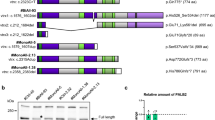Abstract
p53 is the most commonly mutated gene in human cancer. After activation by cellular stresses such as DNA damage or oncogene activation, p53, a sequence-specific DNA-binding protein, induces the expression of target genes which mediate tumor suppression. Two recently identified p53 homologues, p63 and p73, appear to function similarly to p53, that is, they both activate target gene expression and suppress cell growth when overexpressed; however, the p63 and p73 genes are rarely mutated in human cancer and do not adhere to Knudson’s classical model of a tumor suppressor gene. Recently, exciting observations suggest nonoverlapping functions for the family members. Herein, we outline the recent literatures identifying and characterizing both the common and distinct target genes of the p53 family transcription factors in relation to their signaling pathways.
Similar content being viewed by others
Author information
Authors and Affiliations
Corresponding author
Additional information
Received 30 July 2003; received after revision 22 September 2003; accepted 25 September 2003
Rights and permissions
About this article
Cite this article
Harms, K., Nozell, S. & Chen, X. The common and distinct target genes of the p53 family transcription factors. CMLS, Cell. Mol. Life Sci. 61, 822–842 (2004). https://doi.org/10.1007/s00018-003-3304-4
Issue Date:
DOI: https://doi.org/10.1007/s00018-003-3304-4




